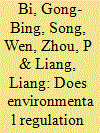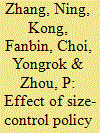|
|
|
Sort Order |
|
|
|
Items / Page
|
|
|
|
|
|
|
| Srl | Item |
| 1 |
ID:
183559


|
|
|
|
|
| Summary/Abstract |
The implementation of renewable portfolio standard (RPS) policy may bring some adverse effects when the region lacks of the capacity to cope with policy stresses. This paper proposes an analytical framework of adaptive capacity index to RPS policy (ACI-RPS) and apply it to evaluate the provincial adaptive capacity to RPS in China over time. The results show that the ACI-RPS in China displayed an increasing trend but declined slightly in 2017 due to the technical bottlenecks. There was a wide disparity in ACI-RPS across the provinces in China, with eastern provinces having the highest but northeastern provinces having the lowest scores. These results indicate that provincial RPS targets need to be set with reference to their adaptive capacity and local energy status. Specifically, more ambitious targets may be assigned to eastern, southern, and northern provinces. It is concluded that the promotion of power grid construction and the acceleration of power marketization are two effective ways to further improve the capacity to cope with RPS policy of a region.
|
|
|
|
|
|
|
|
|
|
|
|
|
|
|
|
| 2 |
ID:
109334


|
|
|
|
|
| Publication |
2011.
|
| Summary/Abstract |
This paper examines the causal relationships between carbon dioxide emissions, energy consumption and real economic output using panel cointegration and panel vector error correction modeling techniques based on the panel data for 28 provinces in China over the period 1995-2007. Our empirical results show that CO2 emissions, energy consumption and economic growth have appeared to be cointegrated. Moreover, there exists bidirectional causality between CO2 emissions and energy consumption, and also between energy consumption and economic growth. It has also been found that energy consumption and economic growth are the long-run causes for CO2 emissions and CO2 emissions and economic growth are the long-run causes for energy consumption. The results indicate that China's CO2 emissions will not decrease in a long period of time and reducing CO2 emissions may handicap China's economic growth to some degree. Some policy implications of the empirical results have finally been proposed.
|
|
|
|
|
|
|
|
|
|
|
|
|
|
|
|
| 3 |
ID:
128027


|
|
|
|
|
| Publication |
2014.
|
| Summary/Abstract |
Data envelopment analysis (DEA) has gained much popularity in performance measurement of power industry. This paper presents a slack-based measure approach to investigating the relationship between fossil fuel consumption and the environmental regulation of China's thermal power generation. We first calculate the total-factor energy efficiency without considering environmental constraints. An environmental performance indicator is proposed through decomposing the total-factor energy efficiency. The proposed approach is then employed to examine whether environmental regulation affects the energy efficiency of China's thermal power generation. We find that the environmental efficiency plays a significant role in affecting energy performance of China's thermal generation sector. Decreasing the discharge of major pollutants can improve both energy performance and environmental efficiency. Besides, we also have three main findings: (1) The energy efficiency and environmental efficiency were relatively low. (2) The energy and environmental efficiency scores show great variations among provinces. (3) Both energy efficiency and environmental efficiency are of obvious geographical characteristics. According to our findings, we suggest some policy implications.
|
|
|
|
|
|
|
|
|
|
|
|
|
|
|
|
| 4 |
ID:
132770


|
|
|
|
|
| Publication |
2014.
|
| Summary/Abstract |
This paper examines the effect of size control policy on the energy and carbon efficiency for Chinese fossil fuel power industry. For this purpose, we propose two non-radial directional distance functions for energy/carbon efficiency analysis of fossil fuel electricity generation. One is named a total-factor directional distance function that incorporates the inefficiency of all input and output factors to measure the unified (operational and environmental) efficiency of fossil fuel power plants, and the other is called an energy-environmental directional distance function that can be used to measure the energy-environmental performance of fossil fuel electric power plants. Several standardized indicators for measuring unified efficiency and energy-environmental performance are derived from the two directional distance functions. An empirical study of 252 fossil fuel power plants in China is conducted by using the proposed approach. Our empirical results show that there exists a significant positive relationship between the plant size and unified efficiency, the five state-owned companies show lower unified efficiency and energy-environmental performance than other companies. It is suggested that Chinese government might need to consider private incentives and deregulation for its state-owned enterprises to improve their performance proactively.
|
|
|
|
|
|
|
|
|
|
|
|
|
|
|
|
| 5 |
ID:
115643


|
|
|
|
|
| Publication |
2012.
|
| Summary/Abstract |
Global awareness on energy security and climate change has created much interest in assessing economy-wide energy efficiency performance. A number of previous studies have contributed to evaluate energy efficiency performance using different analytical techniques among which data envelopment analysis (DEA) has recently received increasing attention. Most of DEA-related energy efficiency studies do not consider undesirable outputs such as CO2 emissions in their modeling framework, which may lead to biased energy efficiency values. Within a joint production framework of desirable and undesirable outputs, in this paper we construct both static and dynamic energy efficiency performance indexes for measuring industrial energy efficiency performance by using several environmental DEA models with CO2 emissions. The dynamic energy efficiency performance indexes have further been decomposed into two contributing components. We finally apply the indexes proposed to assess the industrial energy efficiency performance of different provinces in China over time. Our empirical study shows that the energy efficiency improvement in China's industrial sector was mainly driven by technological improvement.
|
|
|
|
|
|
|
|
|
|
|
|
|
|
|
|
| 6 |
ID:
137695


|
|
|
|
|
| Summary/Abstract |
Shanghai, one of the most developed cities in China, is implementing a pilot regional carbon emission trading scheme. Estimating the marginal abatement costs of CO2 emissions for the industrial sectors covered in Shanghai's emission trading scheme provides the government and participating firms useful information for devising compliance policies. This paper employs multiple distance function approaches to estimating the shadow prices of CO2 emissions for Shanghai industrial sectors. Our empirical results show that the overall weighted average of shadow price estimates by different approaches ranges between 394.5 and 1906.1 Yuan/ton, which indicates that model choice truly has a significant effect on the shadow price estimation. We have also identified a negative relationship between the shadow price of CO2 emissions and carbon intensity, and the heavy industries with higher carbon intensities tend to have lower shadow prices. It has been suggested that Shanghai municipal government take various measures to improve its carbon market, e.g. using the marginal abatement costs of participating sectors/firms as a criterion in the initial allocation of carbon emission allowances.
|
|
|
|
|
|
|
|
|
|
|
|
|
|
|
|
| 7 |
ID:
104911


|
|
|
|
|
| Publication |
2011.
|
| Summary/Abstract |
We present five performance indicators for electricity generation for 129 countries using the 2005 data. These indicators, measured at the national level, are the aggregate CO2 intensity of electricity production, the efficiencies of coal, oil and gas generation and the share of electricity produced from non-fossil fuels. We conduct a study on the potential for reducing global energy-related CO2 emissions from electricity production through simple benchmarking. This is performed based on the last four performance indicators and the construction of a cumulative curve for each of these indicators. It is found that global CO2 emissions from electricity production would be reduced by 19% if all these indicators are benchmarked at the 50th percentile. Not surprisingly, the emission reduction potential measured in absolute terms is the highest for large countries such as China, India, Russia and the United States. When the potential is expressed as a percentage of a country's own emissions, few of these countries appear in the top-five list.
|
|
|
|
|
|
|
|
|
|
|
|
|
|
|
|
|
|
|
|
|